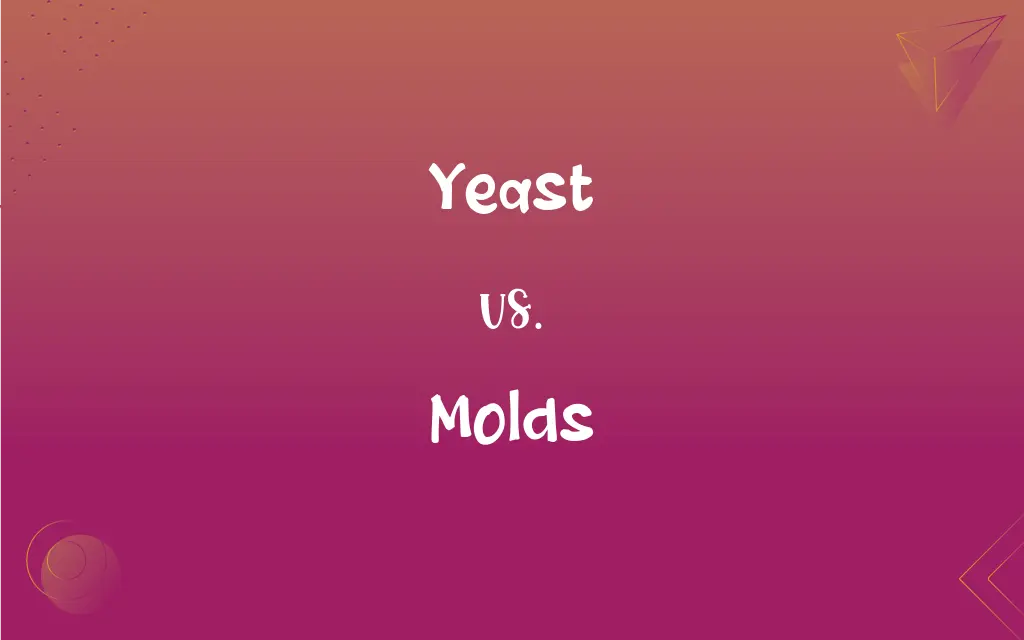Yeast vs. Molds: What's the Difference?
Edited by Janet White || By Harlon Moss || Updated on October 27, 2023
Yeast is a unicellular fungus used in fermentation, while molds are multicellular fungi that grow in filamentous structures.

Key Differences
Yeast are unicellular fungi, often used in baking and brewing due to their fermentation capabilities. Molds, in contrast, are multicellular fungi, known for their filamentous growth and often found on spoiled food.
In yeast, the primary method of reproduction is budding, where a new cell grows out of the parent cell. Molds reproduce through spores, which can spread and grow into new mold colonies.
Yeast cells are generally oval or spherical in shape. Molds, however, form long, thread-like structures called hyphae, which intertwine to form a mycelium.
Yeast plays a beneficial role in food production, like in bread making, where it causes dough to rise. Molds are usually undesirable in food, causing spoilage, though some are used in cheese making.
Yeast typically thrives in moist, warm environments, useful in controlled fermentation processes. Molds can grow in various conditions, often appearing in damp, humid areas.
ADVERTISEMENT
Comparison Chart
Cellularity
Unicellular
Multicellular
Structure
Oval or spherical cells
Filamentous structures (hyphae)
Reproduction
Budding
Spore formation
Role in Food
Beneficial in fermentation (baking, brewing)
Often causes spoilage, but used in some cheeses
Growth Conditions
Prefers moist, warm environments for fermentation
Thrives in various conditions, often damp areas
ADVERTISEMENT
Visibility
Generally not visible to the naked eye
Visible as fuzzy growth
Usage
Used in food and beverage industry
Some used in medicine, others cause contamination
Health Impact
Generally safe, used in food production
Can be pathogenic or allergenic
Economic Impact
Positive in food and beverage industry
Mostly negative, causing food spoilage and damage
Yeast and Molds Definitions
Yeast
An agent of fermentation that converts sugars into alcohol and carbon dioxide.
Yeast is essential for brewing beer.
Molds
A common cause of food spoilage and decay.
Molds made the fruit inedible.
Yeast
A term used in medicine for fungal infections caused by yeast-like fungi.
She was prescribed medication for a yeast infection.
Molds
An organism that reproduces by releasing spores.
The mold in the damp bathroom was releasing spores into the air.
Yeast
A microscopic fungus used in baking and brewing.
The yeast in the dough made the bread rise beautifully.
Molds
A potential indoor air contaminant in damp environments.
They found molds in the basement after the flood.
Yeast
A unicellular organism used in scientific research.
Scientists study yeast to understand cellular processes.
Molds
A substance used in certain types of cheese production.
Blue cheese gets its flavor from specific molds.
Yeast
An active ingredient in many baking recipes.
He added yeast to the mixture to ensure the cake would be fluffy.
Molds
A type of multicellular fungus that grows in a filamentous structure.
There was mold on the bread left out for too long.
Yeast
Any of various unicellular fungi of the genus Saccharomyces, especially S. cerevisiae, reproducing asexually by budding or sexually through the production of ascospores and capable of fermenting carbohydrates.
Molds
A hollow form or matrix for shaping a fluid or plastic substance.
FAQs
What is yeast?
A unicellular fungus used in fermentation.
What are molds?
Multicellular fungi that grow in filamentous structures.
How do molds reproduce?
Molds reproduce through the formation and dispersal of spores.
Can yeast be seen with the naked eye?
No, yeast cells are generally not visible without a microscope.
How do yeast cells reproduce?
Yeast cells reproduce through a process called budding.
Is yeast harmful?
Generally, yeast is safe and used in food production, though some types can cause infections.
Are molds used in medicine?
Some molds are used to produce antibiotics, while others can be pathogenic.
Do yeast and molds have a similar appearance?
No, yeast are unicellular, while molds have a filamentous structure.
Can both yeast and molds cause diseases?
Yes, though not common, both can cause diseases under certain conditions.
Can molds be harmful?
Some molds can be pathogenic or allergenic, but others are used beneficially in food.
Is yeast used in medicine?
Yes, some yeast types are used in medicine and research.
Are yeast and molds found in the same environments?
They can overlap in environments but have different optimal growth conditions.
What is the economic impact of yeast?
Yeast has a positive economic impact, especially in the food and beverage industry.
Can molds be used in food production?
Yes, certain molds are used in producing cheeses and some Asian foods.
Are yeast and molds the same?
No, they are different types of fungi with distinct characteristics.
What is the economic impact of molds?
Molds generally have a negative economic impact due to food spoilage and property damage.
Can yeast be used in baking?
Yes, yeast is a key ingredient in many baking recipes.
Where do yeast thrive?
Yeast thrives in moist, warm environments, especially in sugar-rich settings.
Where do molds grow?
Molds can grow in various conditions but prefer damp, humid areas.
Is mold visible to the naked eye?
Yes, molds can often be seen as fuzzy growth on surfaces.
About Author
Written by
Harlon MossHarlon is a seasoned quality moderator and accomplished content writer for Difference Wiki. An alumnus of the prestigious University of California, he earned his degree in Computer Science. Leveraging his academic background, Harlon brings a meticulous and informed perspective to his work, ensuring content accuracy and excellence.
Edited by
Janet WhiteJanet White has been an esteemed writer and blogger for Difference Wiki. Holding a Master's degree in Science and Medical Journalism from the prestigious Boston University, she has consistently demonstrated her expertise and passion for her field. When she's not immersed in her work, Janet relishes her time exercising, delving into a good book, and cherishing moments with friends and family.































































